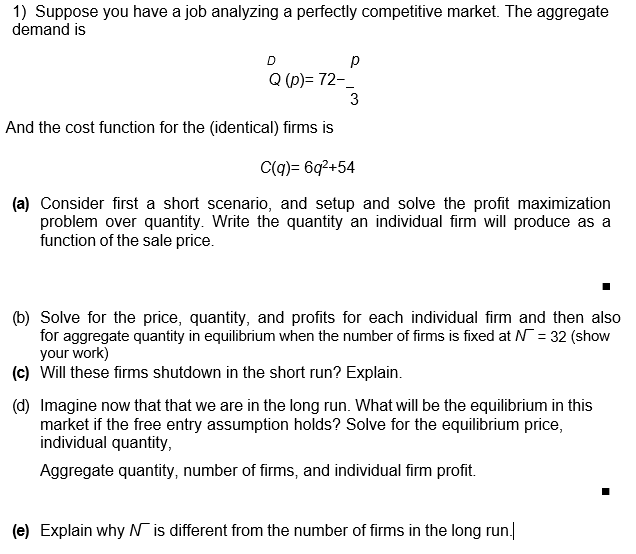1) Suppose you have a job analyzing a perfectly competitive market. The aggregate demand is D Q (p)= 72-_ 3 And the cost function for the (identical) firms is C(q)= 6q2+54 (a) Consider first a short scenario, and setup and solve the profit maximization problem over quantity. Write the quantity an individual firm will produce as a function of the sale price. (b) Solve for the price, quantity, and profits for each individual firm and then also for aggregate quantity in equilibrium when the number of firms is fixed at N = 32 (show your work) (c) Will these firms shutdown in the short run? Explain.
1) Suppose you have a job analyzing a perfectly competitive market. The aggregate demand is D Q (p)= 72-_ 3 And the cost function for the (identical) firms is C(q)= 6q2+54 (a) Consider first a short scenario, and setup and solve the profit maximization problem over quantity. Write the quantity an individual firm will produce as a function of the sale price. (b) Solve for the price, quantity, and profits for each individual firm and then also for aggregate quantity in equilibrium when the number of firms is fixed at N = 32 (show your work) (c) Will these firms shutdown in the short run? Explain.
Chapter2: Mathematics For Microeconomics
Section: Chapter Questions
Problem 2.2P
Related questions
Question

Transcribed Image Text:1) Suppose you have a job analyzing a perfectly competitive market. The aggregate
demand is
D
Q (p)= 72-
3
And the cost function for the (identical) firms is
C(g)= 6q2+54
(a) Consider first a short scenario, and setup and solve the profit maximization
problem over quantity. Write the quantity an individual firm will produce as a
function of the sale price.
(b) Solve for the price, quantity, and profits for each individual firm and then also
for aggregate quantity in equilibrium when the number of firms is fixed at N = 32 (show
your work)
(c) Will these firms shutdown in the short run? Explain.
(d) Imagine now that that we are in the long run. What will be the equilibrium in this
market if the free entry assumption holds? Solve for the equilibrium price,
individual quantity,
Aggregate quantity, number of firms, and individual firm profit.
(e) Explain why N is different from the number of firms in the long run.
Expert Solution
This question has been solved!
Explore an expertly crafted, step-by-step solution for a thorough understanding of key concepts.
This is a popular solution!
Trending now
This is a popular solution!
Step by step
Solved in 4 steps

Knowledge Booster
Learn more about
Need a deep-dive on the concept behind this application? Look no further. Learn more about this topic, economics and related others by exploring similar questions and additional content below.Recommended textbooks for you


Managerial Economics: Applications, Strategies an…
Economics
ISBN:
9781305506381
Author:
James R. McGuigan, R. Charles Moyer, Frederick H.deB. Harris
Publisher:
Cengage Learning


Managerial Economics: Applications, Strategies an…
Economics
ISBN:
9781305506381
Author:
James R. McGuigan, R. Charles Moyer, Frederick H.deB. Harris
Publisher:
Cengage Learning